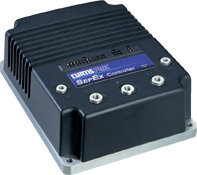
Home / Curtis


SepEx Motor Controller
1244 / 1244 CAN
Curtis PMC Model 1244 SepEx® programmable controllers provide smooth and seamless regenerative control of separately excited motors. An advanced MOSFET power section provides very high efficiency, silent operation and reduced motor and battery losses.
Features
CANbus
A controller-area network (CAN or CAN-bus) is a serial communications bus standard, allowing electronic control modules to communicate with each other within a vehicle. It was originally designed by Bosch specifically for automotive applications. CANopen is an international standard, and is a higher-layer CAN protocol for embedded control systems. CANopen has become the standard communication bus for most electric vehicle applications including forklift trucks and other materials handling vehicles. SAE J1939 is an alternate higher-level protocol that is commonly used for IC engine-powered vehicle applications, such as agricultural vehicles, construction vehicles, and automobiles. Most recent Curtis controllers adhere to the CANopen protocol and support the DS401 IO-device profile standard. Earlier Curtis CAN controllers adhere to the CAN2.0B standard, but run proprietary higher-level protocols called Curtis Nodes 1.0 and Curtis Nodes 2.0. Please note that SAE J1939-compliant variants of certain Curtis products are possible -please contact us for more information.
WalkAway®
The WalkAway® braking feature limits any stopped or key-off vehicle rolling to a very low speed. For instance, if the parking brake is not engaged when a vehicle is left on a slope. The WalkAway® function applies field current via an external relay to slow a vehicle that is detected as moving while the main contactor is open. The motor force created from this function is intended to limit the vehicle's rolling speed, but may not be sufficient to slow heavy vehicles on steep slopes. The vehicle's warning buzzer is pulsed by the controller to create an audible indication that the vehicle is rolling.
Multimode®
Multimode® is a feature available in many Curtis controllers that allows the vehicle user to instantly change an entire set of parameters via switch inputs. These parameters can include speed, acceleration, deceleration and current limits and with MultiMode®, they can be changed between preset levels for up to four different vehicle operating modes. These modes can be programmed to provide four different sets of operating characteristics, which can be useful for operating in different conditions, such as slow precise indoor manoeuvring in Mode 1; faster, long distance, outdoor travel in Mode 4; and application specific special conditions in Modes 2 and 3.
Application
| Application | Traction |
| Vehicle Type | Industrial |
| Max Voltage [VDC] | 36 |
| Armature Current (2 min) [A] | 200 - 350 |
| Field Current (2 min) [A] | 25 - 35 |
| WalkAway® | No |
| Control Method | Speed |
| Field Mapping | Yes |
| MultiMode® | Yes |
| VCL | No |
| CANbus | Option |
| 840 Spyglass support | Yes |
| IP Rating | IP 53 |
Do you have any query? Call +(91)-9822775764. Or Request a Quote
Designed & developed by Satkar Infotech
Terms & Conditions |
Privacy Policy |
Dispute Policy
Copyright © 2017 by MEL Services.








